Bulletin: RollerTrol™ Automation Systems is Launched!
- We have been busy making and selling roller blinds and projector screens for some time, and we have decided to start selling the components at
RollerTrol.com so others can do the same.
- Take a look at our online store for tubular motors and other associated products - make your own custom shade or screen size
that fits your room perfectly! We also have special motor kits that work with x10 automation systems.
- While you're at it, check out our tubular motors with built-in radio controllers. When used with our multi-channel remotes, you can control the screen AND blackout blinds with a single remote!
End Bulletin: RollerTrol™ Automation Systems
I was getting
frustrated with my HTPC system for a number of reasons. I
didn't have a fast enough machine to improve the picture resolution over
a regular DVD, (except for the WinDVD program) I couldn't get the
Dolby 5.1 audio to feed through to my decoder sound system (only stereo
L+R), and I was getting momentary pauses and glitches while playing a
film.
I particularly wanted the best possible picture I could get, and that
included upscaling (or upsampling) - a method of using the existing DVD
video data to create extra lines of resolution, which results in a more
detailed picture. This is especially beneficial when watching a large
10' screen like mine. Keeping in mind that this process is not true HDTV
(the standard DVD format is not a true High Definition format), the
results are nevertheless a significant improvement over the usual 480p
that a regular DVD player puts out.
I was faced with the decision of having to spend considerably more money
to buy a faster HTPC, as well as the possibility of having to spend
countless hours trying to make it work properly. I had reached the point
where I just wanted to sit down and watch some good movies in high
resolution mode, and stop messing around with computers. So, what to do?
It was about that
time that I had noticed a new DVD player from Zenith (DVB 318) that had
the ability to upscale regular DVD movies to 1080i AND deliver
that signal on the component video outputs. This second feature is
especially important for the BenQ 6200 series of projectors because they
don't have a DVI digital input. They can, however, accept a component
video input (YPbPr) running at a resolution of 1080i (roughly double the
regular DVD picture resolution of 480p). This player is one of the very
few that can do this, using the top notch Faroudja chip for upconversion,
and apparently has the best quality output amongst
competitors.

I found it on Ebay for under $200, and I decided to give it a
try as I was tired of doling out cash and time on this project and not
getting the results I wanted. So, I took the leap of faith and placed my
order, hoping this might be the solution for me.
It wasn't long before
it arrived at the door, and I opened the box with some trepidation,
although I have bought many Zenith products in the past and found them
to be of very high quality. I used to service their TV consoles in the
early seventies, and developed my appreciation for their manufacturing
quality and engineering prowess at that time.
My first impression was that it had a simple, clean appearance and a low
profile that allowed it to fit very neatly into the top shelf of my home
theater console. Most important, it had the upconversion button right on
the front of the unit. Don't get confused by synonymous terms: whether
you call it upscaling, upsampling, upconverting, it all ads up to the
same thing - the interpolation of existing video information at a lower
resolution to create a higher level of detail that simulates HDTV
quality. This unit uses the Faroudja chip to do the upscaling.
So I plugged it in,
connected it to the component inputs on my projector (the BenQ PB6200
doesn't have digital input), and fired it up.
The unit greets you with a friendly "hello" on the unit
display, and the video starts up with a Zenith splash screen at the regular 480p resolution,
before you insert the DVD. I hit the upconversion button to see what
would happen, the projector immediately switched to 720p, and I could
see a definite increase in the sharpness of the picture. Holding my
breath, I hit the upconversion button again and, lo and behold, the
projector snapped into 1080i mode and the screen definition improved
once again to what I thought was a very sharp picture indeed.
Here are some close-up screenshots of the 3 resolution steps. Please keep in mind
these were shot with a digital camera, compressed into jpeg files, and
resized for the net, so you won't actually see what I'm seeing on the
screen with my own eyes, but it will give you an idea of the difference
nevertheless:
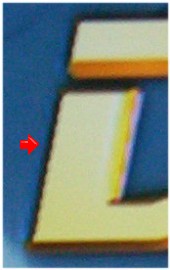 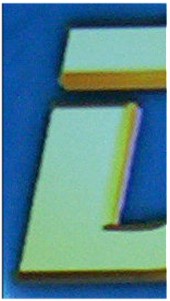
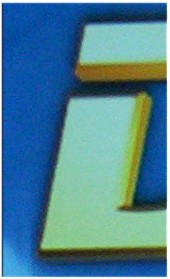
The picture on the left is 480p, the center is the upscaled result at
720p, and the right hand picture is the result of upconversion to 1080i.
The difference is especially apparent if you compare the jaggies (arrow)
on the
angled edge at the left side of the picture.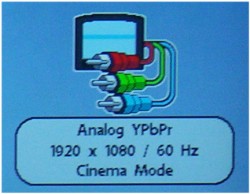
The BenQ 6200 projector very nicely pops up a little window displaying source
information briefly in the corner of the screen every time you change
the source input, and there it was:
Analog YPbPr @ 1920 x 1080 @ 60 Hz
Ok, so now I was getting excited, and I popped my Step Into Liquid DVD
into the machine and hit the play button. Would it look good, I thought?
Would the full Dolby surround come through?
As the DVD spun up, a crystal clear picture appeared, my Dolby receiver
locked into decode mode, and I was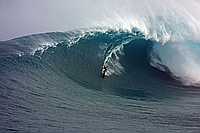 watching Laird Hamilton riding inside
the curl of a 50 foot wave in perfectly clear, sharp detail, with a
kilowatt of 8 channel sound shaking the foundation of my home ...
finally! watching Laird Hamilton riding inside
the curl of a 50 foot wave in perfectly clear, sharp detail, with a
kilowatt of 8 channel sound shaking the foundation of my home ...
finally!
So that's it folks, we've been enjoying brilliant results ever since,
and I feel we've reached an affordable level of performance that will
last us for some time, until the new true high definition formats
arrive. A few final conclusions are in order here:
-You can save money and time and still get great results with the
BenQ/Zenith/rolled screen combination.
-If you go the HTPC route, get the fastest machine you can afford, and
buy from a company that will guarantee the results.
I haven't bothered purchasing an HDTV cable or satellite box because
there just isn't enough interesting content available yet. We find that
playing DVD is the best way to watch movies on the big screen -
definitely the best quality, and it's nice to control when and how many
times you watch.
We watch 2 or 3 films a week, and gave up going to the local video
store; it's too much hassle. For a monthly fee of around $17.00 you can choose from thousands of movie
titles at online stores such as Netflix. The first three available titles
you choose get sent to your home, and when one DVD is returned, the next DVD on
your list is sent.
This is the end of this article series for now, but I'll be
upgrading when that happens, or when the new HDTV DVD format arrives, so stay tuned.
I hope the information was
helpful for your own quest; happy viewing to you! (for complementary home automation products such as lighting control and motorized blinds and shades, see our home automation DIY kit article)
* * * * *
|
For the sake of clarity, here are some acronym and terminology definitions relating to
the various display technologies, used in the other table below to compare the
various screen types:
| TERM |
DEFINITION |
| TLA |
Three Letter
Acronym |
| HDTV |
High Definition
Television. The highest quality video picture
available in Digital TV. In the U.S., the 1080i and 720p
resolution formats in a 16:9 aspect ratio are the two acceptable
HDTV formats. Regular NTSC analog TV is 480i. |
| HTPC |
Home Theater
Personal Computer. The use of a PC as a processing
and source control platform for a home theater system. |
| RPTV |
Rear Projection
TV. The type of home theater screen system where the image
is projected onto the back of the screen. Can be DLP, LCD, CRT
projection technology. |
| Lumens |
An ANSI Lumen is
a measurement of light radiation or brightness. A 3,000 Lumen
projector creates a brighter picture than a 2,000 Lumen unit. The ANSI
prefix is a standards designation (American National
Standards Institute). |
| Nits |
Plasma and LCD
manufacturers use this term to define the brightness of their
screens. Another term for Nits is Candelas per square meter (Cd/m2).
One nit = 0.2919 foot-lambert. Nits includes an area definition,
unlike lumens, so you can't simply divide by Watts to establish a
Nits/watt spec. |
| 480i 720p
1080p |
resolution
measurement in lines, p for "progressive
scan", i for "interlaced scan".
Conventional TV (e.g. 480i) is interlaced whereby the screen is
scanned twice by alternate lines that are interleaved
(interlaced), whereas HDTV (e.g. 720p) can scan all lines
sequentially (consecutively or progressively). |
| DVI HDCP |
Digital Visual
Interface technology with High-bandwidth Digital
Content Protection. Developed by Intel Corporation,
HDCP is a specification to protect digital entertainment content
through the DVI interface. The HDCP specification provides a
transparent method for transmitting and receiving digital
entertainment content to DVI-compliant digital displays. Some
products, such as set-top boxes and DVD burners will require this
connector. Even if you have a HDTV set-top box, if it lacks the
DVI, your signal may be degraded. |
| HDMI |
High Definition
Multimedia Interface. Like DVI, HDMI is another
digital interface, and from what we saw at CES 2005, it may become
the universal standard. Developed by Sony, Hitachi, Thomson (RCA),
Philips, Matsushita (Panasonic), Toshiba and Silicon Image, the
High-Definition Multimedia Interface (HDMI) has emerged as the
connection standard for HDTV and the consumer electronics market.
HDMI is the first digital interface to combine uncompressed
high-definition video, multi-channel audio and intelligent format
and command data in a single digital interface. |
| SACD |
Super Audio
CD uses a new recording technology called Direct Stream
Digital. DSD records a one bit digital signal at a
sample rate of 2.8 million times per second, 64 times higher than
conventional CD's.
|
| NTSC |
Existing color
TV standard developed in the U.S. in 1953 by the National Television
System Committee. NTSC vertical line resolution is
525 lines/frame and the vertical frequency is 60Hz. The NTSC frame
rate is 29.97 frames/sec.
|
| CRT |
Cathode Ray
Tube - venerable old style picture tube |
| PDP |
Plasma Display
Panel, plasma is a physics term for an electrically charged
gas |
| LCD |
Liquid Crystal
Display, same as laptop screens |
| TFT |
Thin Film
Technology, a type of LCD |
| DLP |
Digital Light
Processor, a reflective light switch chip developed by TI.
Has a very fast response time - no motion lag |
| TI |
Texas Instruments
Corp., original manufacturer of DMD's and DLP's |
| DMD |
Digital Micro-mirror
Device - chip for DLP technology by TI |
| DNIe |
Digital Natural
Image enhancement - chip for optimizing video
picture quality, by Samsung (used in their DLP units) |
| LCoS |
Liquid Crystal
on Silicon, reflective light switch |
| SXRD
projection |
Silicon X-tal Reflective Display:
Sony's incarnation of LCoS technology. Sharp picture, no pixelation, very high resolution, reflective
system won't burn out picture element, "no moving parts"
design usually incorporates 3 imaging chips for primary colors,
instead of color wheel. |
| SED |
Surface conduction
Electron emitter Display by Toshiba/Canon |
| FED |
Field Emission
Display: New technology from Sony |
| OLED |
Organic Light
Emitting Diode display: new technology from Seiko-Epson |
| D-iLA |
Direct
Drive Image Light Amplifier, LCoS chip
developed by JVC |
| QXGA |
high screen
resolution of 2048 x 1536, attained by D-iLA chip |
| DCDi |
Directional
Correlation Deinterlacing (a de-interlacing
method to eliminate jagged edges (jaggies) along diagonal lines
caused by interpolation, developed by Faroudja corp. An
important feature to look for, this Emmy® award
winning technology was once only available in products costing
$20,000 or more, and is now available in numerous products costing
well below $2,000 |
| aspect ratio |
ratio of screen
width to height. An aspect ratio of 4:3 is conventional TV and
16:9 is HDTV (and film) |
| 3-2 pulldown |
a method of
film-to-video conversion |
| twitter and
judder |
terms describing
film conversion related artifacts |
| anamorphic
lens |
a special lens
that compresses the pixels of a 4:3 screen into a 16:9 format, and
allows a projector to use the full brightness of the display,
without black bars above and below the image. Must normally be
removed for regular 4:3 viewing. |
| SDE |
Screen Door
Effect is a term used to refer to the visible pixel
structure on a screen. |
| YADR! |
Yet Another
Dang Remote! A common exclamation heard from people
who just bought their third or fourth home audio/video component.
And then there are further unmentionable expletives when you find
out a component isn't supported, or it's just too complicated to
program everything in?? Maybe it's time to read about our experience in the remote
control review article. |
The following table provides a quick comparison of the display types;
"pixelation" refers to the ability to see individual picture elements
(pixels) at normal viewing distances (note that all the types below can
contribute to the YADR index). Please note that these products are being
constantly improved and not all manufacturer's models may be subject to
the disadvantages listed below:
| DISPLAY
TYPE |
PRO
- ADVANTAGE |
CON
- DISADVANTAGE |
CRT
conventional
picture tube |
Cathode Ray
Tube: very
sharp and bright, high contrast ratio, good picture view from
side, low cost, handles regular analog NTSC channels well, no
moving parts |
heavy
and bulky, limited in size to about 36", picture can fade |
CRT
projection
|
low
cost, large screens possible, no moving parts |
heavy
and bulky, limited viewing angles, visible raster lines, mis-convergence
can be a problem, picture can fade over time |
| LCD flat
screen panel |
Liquid Crystal
Display: bright,
sharp picture, light and compact, can hang on wall, solid state,
no moving parts |
picture can fade over time |
| LCD
projection |
fairly
bright, large screens possible, sharp picture, no moving parts |
display can fade due to heat damage to
organic compounds that some manufacturers use in the LCD,
projector bulb can fail |
| PDP Plasma
flat screen panel |
Plasma Display
Panel: bright
picture, light and compact, can hang on wall, wide viewing angle,
no moving parts, handles fast motion really well |
expensive,
some pixelation, display can burn out. |
| DLP
projection |
Digital Light
Processor: bright,
sharp picture, high contrast, no pixelation, reflective
system won't burn out picture element, very fast response time -
no motion lag. |
possible visual "rainbow" artifacts on single chip versions
caused by spinning color wheel, projector
bulb can fail |
| LCoS
projection |
Liquid Crystal
on Silicon: bright,
sharp picture, no pixelation, very high resolution, reflective
system won't burn out picture element, "no moving parts"
design usually incorporates 3 imaging chips for primary colors,
instead of color wheel. |
projector bulb can
fail |
| SXRD
projection |
Silicon X-tal Reflective Display:
Sony's incarnation of LCoS technology. Sharp picture, no pixelation, very high resolution, reflective
system won't burn out picture element, "no moving parts"
design usually incorporates 3 imaging chips for primary colors,
instead of color wheel. |
projector bulb can
fail |
| SED
panel display |
Surface conduction Electron emitter Display:
very bright
picture, very high resolution, can hang on wall, very high
contrast ratio, can be viewed from any angle,
no moving parts, handles fast motion really well |
expensive at
first, not available yet |
| FED
panel display |
Field Emission
Display: New technology from Sony, properties are similar
to SED |
expensive at
first, not available yet |
| OLED
panel display |
Organic Light
Emitting Diode display: new technology from Seiko-Epson |
expensive at
first, not available yet |
|







 watching Laird Hamilton riding inside
the curl of a 50 foot wave in perfectly clear, sharp detail, with a
kilowatt of 8 channel sound shaking the foundation of my home ...
finally!
watching Laird Hamilton riding inside
the curl of a 50 foot wave in perfectly clear, sharp detail, with a
kilowatt of 8 channel sound shaking the foundation of my home ...
finally!